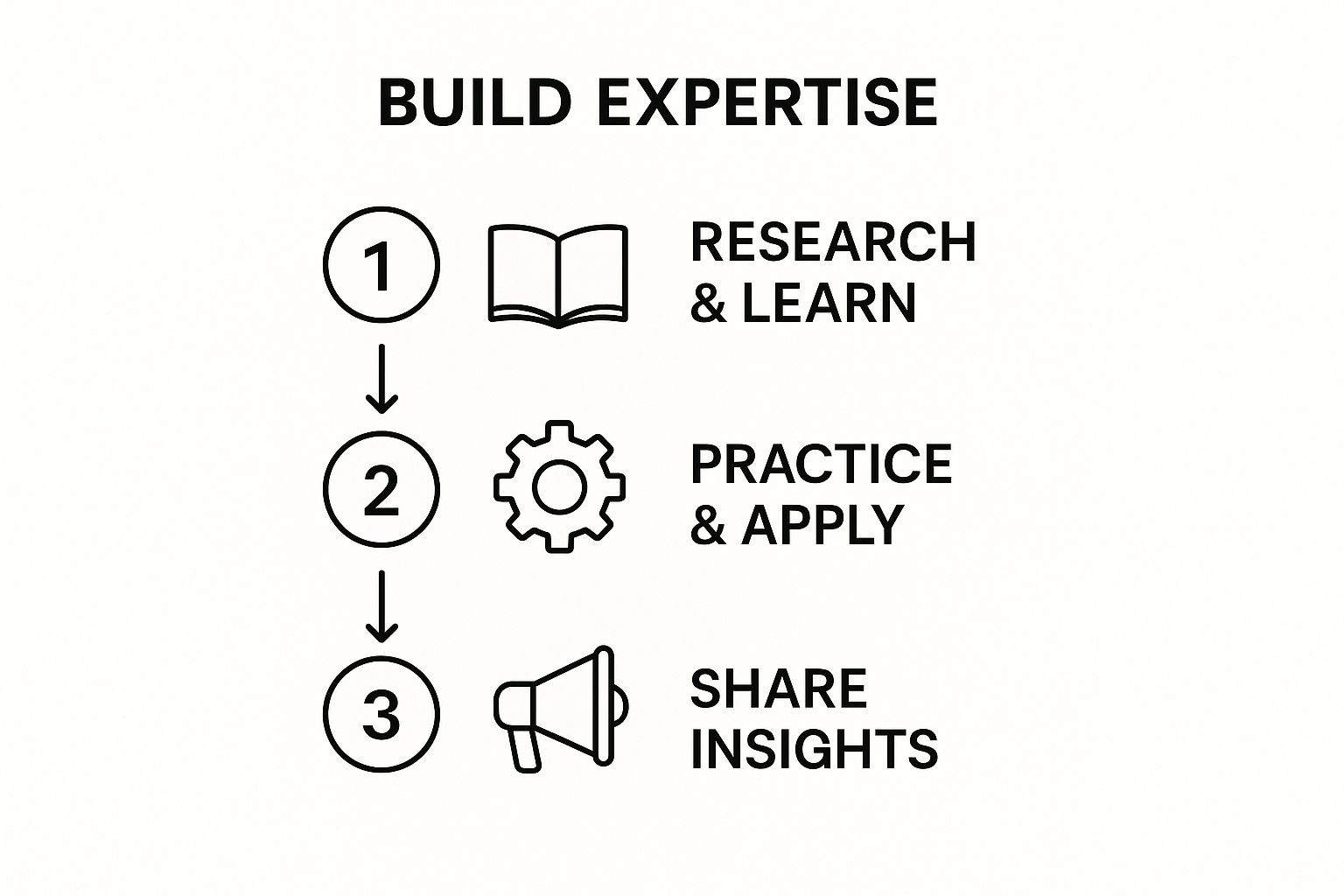How To Become A Thought Leader: Your Complete Action Plan

Understanding What Real Thought Leadership Actually Means
Let's cut through the hype and define what genuine thought leadership really is. It's not about chasing fleeting social media popularity, but about changing industry conversations and offering fresh perspectives. This requires a fundamental shift in thinking—moving from passively observing trends to actively shaping them.
Beyond the Buzzword: Defining True Thought Leadership
Authentic thought leaders aren't created overnight. They build credibility by consistently providing value to their audience, not through showy self-promotion. This means sharing insightful analyses, original research, and practical advice that helps others solve real problems. For instance, a thought leader in social media marketing might publish original research on new platform trends, rather than just regurgitating common knowledge. This value-driven approach distinguishes true experts from attention-seekers.
Furthermore, genuine thought leadership comes with responsibility. As your influence grows, so does your obligation to use it ethically and wisely. It's about contributing positively to your field and encouraging meaningful discussions. It's not about churning out content for content’s sake, but about contributing significant ideas that propel conversations forward.
One of the most compelling statistics about becoming a thought leader is the role it plays in decision-making. According to the Value of Thought Leadership 2025 report, a striking 99% of buyers consider thought leadership important or critical in their decisions. Find more detailed statistics here. This emphasizes the influence of authentic thought leadership on shaping not only conversations, but also business choices.
Separating the Authentic From the Imitators
A key difference between genuine thought leaders and mere imitators lies in their approach to content. True thought leaders create content that benefits their audience, not just themselves. They prioritize providing value, stimulating discussion, and offering unique viewpoints. This requires moving beyond superficial commentary and delving deeply into the issues that matter most to their audience.
Moreover, they understand that building a community around their expertise is crucial. Thought leaders don't just broadcast their ideas; they actively engage in two-way conversations, cultivating authentic connections with their audience. This involves actively listening to feedback, answering questions, and participating in relevant discussions. This interactive approach builds trust and establishes them as a valuable resource in their field. This positions them not merely as experts, but as trusted advisors.
Building Your Foundation of Deep Expertise

True thought leadership begins with a solid foundation of expertise. It's about developing a deep understanding that transcends superficial knowledge. This involves continuous learning, putting knowledge into practice, and strategically developing your skills. It's a journey of becoming a true authority in your chosen domain.
Continuous Learning and Knowledge Development
To become a thought leader, commit to ongoing learning. The business landscape is constantly evolving. Staying up-to-date requires regularly exploring industry publications, attending relevant conferences, and participating in workshops.
Subscribing to leading journals in your field, for example, can provide valuable insights into emerging trends. Consider engaging with online courses or certifications through platforms like Coursera to refine and expand your skillset.
Putting your newfound knowledge into practice is also key. This practical application solidifies understanding and reveals areas for improvement. It's akin to learning a new language: fluency comes from speaking and listening, not just from textbooks.
Original Research and Unique Insights
Thought leaders don't just reiterate existing ideas; they generate original insights. This often involves conducting independent research or performing unique analyses.
For instance, a thought leader in project management might survey project professionals on a particular methodology to uncover insightful trends and challenges. These original contributions boost credibility.
Identifying knowledge gaps within your field is another important aspect. What questions remain unanswered? What perspectives are missing? Focusing on these areas positions you to make significant contributions.
Knowledge Management and Sharing Expertise
A personal knowledge management system is essential. This involves actively organizing and documenting what you learn. Think of it as building your own personal library of expertise. This allows you to easily access and apply your knowledge. Tools like Evernote or dedicated research databases can be valuable assets.
Finally, engaging with other experts is crucial for growth. Participating in industry forums, attending conferences, and joining online communities provides diverse perspectives. These interactions validate your understanding and help identify blind spots. Actively listening, asking insightful questions, and contributing meaningfully builds your reputation as a thought leader.
Creating Content That Builds Real Authority
Not all content contributes equally to building thought leadership. In fact, a lot of published material can actually weaken, rather than strengthen, your authority. This section explores what makes content truly valuable and how it can position you as a recognized expert.
Original Perspectives: Adding Value, Not Just Noise
Becoming a thought leader requires offering original perspectives. This involves going beyond summarizing existing information and instead, contributing unique insights. Think of an architect – they don't simply replicate existing blueprints. They assess the location, the client's needs, and create a unique vision. You should approach your industry in a similar way, analyzing challenges and offering fresh solutions.
This means performing original research, analyzing data from new angles, and developing your own frameworks for understanding complex issues. Exploring platforms with robust development frameworks can also contribute to your expertise. For example, consider the current trends in Laravel web development. Focusing on original thought distinguishes you from those who simply rehash existing content.
Choosing the Right Content Format for Decision-Makers
The format you choose is just as critical as the message itself. Decision-makers are busy. They need information presented clearly, concisely, and in digestible formats. This could mean short, insightful blog posts, data-driven infographics, engaging videos, or comprehensive white papers.
The key is understanding your audience's preferences and tailoring your content to them. For instance, if your audience primarily uses LinkedIn, optimize your content for that platform. Articles like this one on mastering LinkedIn with different content formats can be helpful. Experiment to see what resonates most effectively with your target audience.
Consistency and Adaptability Across Platforms
While adapting to various platforms and audiences, maintain a consistent voice and message. This consistency builds recognition and reinforces your expertise. Just like a recognizable brand logo stays consistent across different applications, your voice and message should create a cohesive brand experience.
This doesn't mean being rigid. It means adapting your core message to resonate with specific audiences on different platforms while retaining a consistent brand identity. This ensures your content consistently reinforces your authority.
Content Planning and Optimization for Thought Leadership
Effective thought leaders utilize proven frameworks for planning, creating, and optimizing their content. The infographic below illustrates the three key steps to building expertise: Research & Learn, Practice & Apply, and Share Insights.

This infographic emphasizes the cyclical nature of expertise development, highlighting the importance of continuous learning, practical application, and sharing insights. Sharing your knowledge reinforces and expands your own understanding, a crucial component of thought leadership.
The following table provides a comparison of various content formats and their effectiveness in establishing thought leadership authority.
Content Types And Their Authority-Building Impact
| Content Type | Authority Impact | Audience Reach | Time Investment |
|---|---|---|---|
| Blog Posts | High | Medium | Medium |
| Infographics | Medium | High | High |
| Videos | High | High | High |
| White Papers | High | Low | Very High |
As the table shows, different content types offer varying levels of authority impact, audience reach, and required time investment. While white papers offer a significant authority boost, they require a substantial time commitment. Blog posts and videos can provide a balance between authority building and reach. Infographics offer broad reach but require a significant time investment for creation.
A structured approach, including keyword research and optimization, ensures your content systematically builds your reputation, reaching the right audience. Remember, you're not just creating content; you're building a lasting legacy of thought leadership.
Strategic Distribution That Reaches Decision-Makers

Crafting compelling content is only the first step. To truly establish yourself as a thought leader, your insights need to land in front of the right people – the decision-makers. This requires a deep understanding of your audience's information consumption habits and a distribution strategy that caters to them. It's not about blanket coverage across every platform; it's about strategically focusing your efforts where they'll have the most impact.
Mapping Your Audience and Identifying Key Channels
Begin by mapping your audience’s content consumption habits. Ask yourself: where do they spend their time online? What publications grab their attention? Which conferences do they attend? This research helps you prioritize distribution platforms effectively.
For instance, if your target audience is C-suite executives, concentrating on LinkedIn and industry-specific publications might be a more effective approach than TikTok or Instagram. This focused strategy maximizes reach and engagement. Consider resources like this guide on How to master your LinkedIn Content Strategy for platform-specific best practices.
Organic vs. Paid Distribution: Finding the Right Balance
After pinpointing your key channels, the next step is determining the optimal blend of organic and paid distribution. Organic distribution involves sharing content through your owned channels, like your website, social media profiles, and email lists. This approach fosters genuine engagement but can be time-intensive.
Paid distribution, conversely, utilizes advertising or sponsored content to broaden your reach. While paid methods can rapidly expand your audience, they require budget allocation. The most effective strategy often combines both, harnessing the unique strengths of each.
A recent study revealed that 24% of senior leaders engage with thought leadership content daily, and 31% engage weekly. You can learn more about thought leadership engagement. This data underscores the need for content tailored to the consumption patterns of key decision-makers.
Building Relationships and Amplifying Your Voice
Building relationships with industry influencers is invaluable. Collaboration on content, participating in joint webinars, or even simply interacting with their content on social media can significantly amplify your message. These connections introduce your content to new audiences.
Equally crucial is engaging meaningfully with your audience’s responses. Addressing comments and questions nurtures a sense of community and demonstrates genuine interest in their perspectives, establishing you as a trusted resource.
Measuring Reach and Refining Your Strategy
Finally, consistently measuring the effectiveness of your distribution strategy is essential. Track key metrics like website traffic, social media engagement, and lead generation. Analyzing this data allows you to fine-tune your approach, identifying what’s working and areas needing improvement. This data-driven approach ensures continuous improvement in reaching and influencing your target audience.
Building Networks That Actually Support Your Goals
Building a strong network is essential for any aspiring thought leader. But real thought leadership isn't about collecting contacts; it's about cultivating genuine connections. This section explores how to build a network that actively supports and amplifies your thought leadership journey.
Identifying Key Players and Building Meaningful Relationships
Begin by identifying key influencers and decision-makers within your industry. These are the individuals whose opinions carry weight and who can help spread your message. Think of your network like a web – the stronger the individual strands, the more resilient the overall structure. Approach these individuals not with a request, but with a value proposition. How can you contribute to their success? This mutually beneficial approach is fundamental to building enduring professional relationships.
For example, if you're a marketing expert, consider offering your expertise in a guest blog post on an influencer's website. This expands your reach while providing valuable content to the influencer. This collaborative approach is much more effective than simply asking for a retweet.
The Art of Collaborative Thought Leadership
After identifying key players, focus on building authentic relationships. This involves more than just adding them on LinkedIn. Engage with their content, offer thoughtful comments, and participate in relevant discussions. Become a valuable member of the community, contributing in ways that enhance your reputation.
Also, participate authentically in industry discussions. Don't just jump in to promote yourself. Offer insightful perspectives, ask pertinent questions, and contribute meaningfully to the conversation. This demonstrates genuine interest and builds credibility.
Once you’ve created content that builds your authority, the next step is effective promotion. A well-planned content distribution strategy can be incredibly helpful.
From Casual Connections to Strategic Partnerships
Turn casual connections into lasting professional relationships by focusing on long-term value. Networking events are a good starting point, but the real work begins afterward. Follow up with the people you meet, personalize your outreach, and find ways to maintain contact. This consistent effort builds rapport and strengthens your connections within the network.
Consider offering to collaborate on projects or share each other's work. This mutual support strengthens the relationship and expands your reach. Remember, becoming a thought leader is about building a community, not just accumulating followers.
Online and Offline Networking Strategies for Thought Leadership
Effective networking isn't confined to conferences and in-person events. Utilize online platforms like LinkedIn, Twitter, and industry-specific forums to connect with influencers and peers. Engage in thoughtful discussions, share valuable insights, and strategically build your online presence.
This multifaceted approach maximizes your networking potential. Engaging online creates visibility and accessibility, while offline interactions foster deeper relationships. This balanced approach is essential for building a robust network that supports your thought leadership goals. Ultimately, your network becomes an amplifier for your message, extending your reach and propelling you toward becoming a recognized thought leader.
Measuring Impact and Refining Your Approach

Becoming a thought leader is a continuous journey. It’s about consistently evaluating your influence and adapting your strategy based on data and audience feedback. This means shifting focus from vanity metrics like follower counts to indicators that demonstrate true impact.
Identifying Key Performance Indicators (KPIs)
To accurately measure your progress, identify key performance indicators (KPIs) that align with your thought leadership objectives. These KPIs should reflect both the quality of engagement and the tangible business outcomes you're aiming for.
Engagement Quality: Go beyond simply counting likes and shares. Instead, delve into the depth of interaction with your content. Are people engaging in thoughtful discussions? Are they sharing your insights within their own networks? These actions signal genuine influence. For example, comments debating your ideas, even critical ones, show that your content is stimulating conversation and shaping perspectives.
Reputation Growth: Monitor the evolution of your professional reputation. Are you being invited to speak at conferences? Are industry publications quoting you? Are you seeing a rise in inbound inquiries? These are all strong indicators of increasing recognition in your field.
Business Impact: Ultimately, thought leadership should drive tangible business results. This might include increased sales, new partnerships, or heightened brand awareness. Measuring these outcomes is essential for demonstrating the value of your thought leadership efforts.
Quantitative and Qualitative Measurement
Effective measurement involves both quantitative and qualitative approaches. Quantitative data, such as website traffic and social media engagement metrics, provides a broad overview of your reach. Qualitative data, such as audience feedback and industry recognition, offers deeper insights into how your thought leadership is perceived and its influence on decision-making.
For instance, analyzing website traffic in conjunction with audience surveys can reveal who is consuming your content and how it's influencing their decisions. Combining these data sources paints a more complete picture of your thought leadership effectiveness.
To help visualize key metrics and their measurement, consider the following table:
Key Thought Leadership Performance Metrics Essential metrics for measuring thought leadership success and business impact
| Metric Category | Specific Indicators | Measurement Method | Success Benchmarks |
|---|---|---|---|
| Engagement Quality | Comments, Shares with insightful commentary, Social media discussions | Social listening tools, Brand24 | High levels of thoughtful interaction, Content shared by influencers |
| Reputation Growth | Speaking invitations, Media mentions, Inbound inquiries | Media monitoring tools, CRM data | Increased frequency of invitations and mentions |
| Business Impact | Sales growth, New partnerships, Brand awareness lift | Sales data, Partnership agreements, Brand tracking studies | Measurable improvements in business outcomes |
This table outlines key areas to track and how to measure them, enabling you to establish clear benchmarks for success. By monitoring these metrics, you can gain valuable insights into the effectiveness of your thought leadership strategy.
Gathering and Utilizing Audience Feedback
Actively seek feedback from your audience. Conduct surveys, participate in Q&A sessions, and monitor online conversations surrounding your content. This direct feedback offers valuable insights into what resonates with your audience, areas for improvement, and how to better tailor your content to their needs.
This means taking both positive and negative feedback to heart. While positive feedback is encouraging, constructive criticism can be even more valuable for refining your approach. Use this feedback to make informed adjustments to your content strategy and overall thought leadership strategy.
You might be interested in: How to master content repurposing to maximize your reach.
Continuous Optimization and Strategic Pivoting
Thought leadership is a dynamic process. As your expertise and market positioning change, so should your approach. Consistently analyze performance data and audience feedback to identify what's working, what needs adjustment, and opportunities for strategic pivots. This iterative process ensures your thought leadership stays relevant, impactful, and aligned with your objectives.
This could involve experimenting with different content formats, exploring new distribution channels, or refining your target audience. The key is to remain adaptable and embrace change as a natural part of the thought leadership journey. By consistently measuring, refining, and evolving your approach, you can ensure your thought leadership continues to resonate and achieve meaningful results.
Key Takeaways
Your journey to becoming a thought leader is more of a marathon than a sprint. It takes a strategic combination of deep expertise, compelling content, impactful distribution, and genuine networking. This section breaks down the key takeaways into actionable steps, offering a practical roadmap to success.
Building a Foundation of Expertise
Continuous Learning is essential. Don't just try to keep up; aim to stay ahead of the curve. Regularly explore industry publications, attend conferences, and consistently seek out new knowledge to deepen your expertise.
Practical Application is just as important. Knowledge without application is like a car without an engine. Put your knowledge into practice to solidify your understanding and identify areas for improvement.
Identifying Knowledge Gaps is key to standing out. Be curious and seek out unanswered questions and unexplored perspectives. This positions you to make significant contributions to your field.
Creating Content That Resonates
Original Perspectives are vital in a crowded information landscape. Avoid simply rehashing existing content. Instead, contribute unique perspectives, fresh solutions, and new frameworks.
Targeted Content Formats help you connect with your audience more effectively. Understand their preferences and tailor your content accordingly. From concise blog posts to data-driven infographics, choose the medium that maximizes impact.
Consistency and Adaptability go hand-in-hand. Maintain a consistent voice across different platforms while adapting your message to resonate with specific audiences. This builds brand recognition and strengthens your authority.
Strategic Distribution and Networking
Targeted Distribution maximizes your reach. Identify the platforms and channels where your target audience spends their time, and focus your distribution efforts there. This ensures your content reaches the right decision-makers.
Organic and Paid Reach both play a role in a successful strategy. Organic methods cultivate authentic engagement, while paid promotion rapidly expands your reach. A balanced approach leverages the strengths of both.
Authentic Networking is about building genuine relationships, not just collecting contacts. Offer value to others and actively participate in industry discussions. This fosters trust and strengthens your influence.
Measuring Impact and Continuous Improvement
Meaningful Metrics provide valuable insights into your progress. Focus on metrics that truly matter, like engagement quality, reputation growth, and demonstrable business impact. Avoid chasing vanity metrics that don’t reflect real-world influence.
Audience Feedback is essential for refinement. Actively solicit feedback through surveys, Q&A sessions, and by monitoring online conversations. This feedback offers invaluable insights for improvement and course correction.
Continuous Refinement is the cornerstone of long-term success. Thought leadership is an ongoing process. Consistently analyze data and feedback to adapt your strategy and ensure sustained relevance and impact.
Are you ready to elevate your content and amplify your thought leadership? Lumeo empowers you to create compelling carousel presentations that captivate audiences and drive engagement. Transform your existing content into dynamic visuals and enhance your online presence. Start building your thought leadership with Lumeo today!